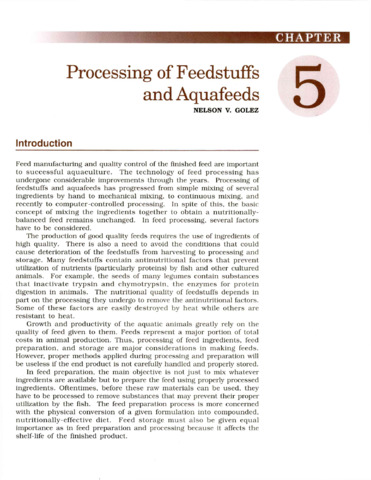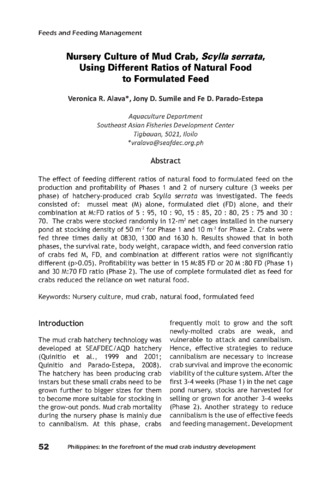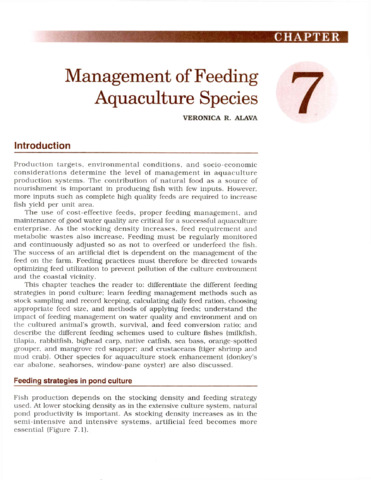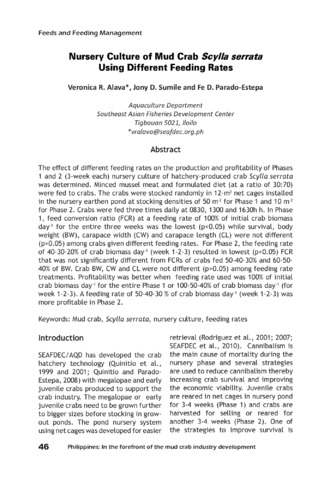Processing of feedstuffs and aquafeeds

ရှာဖွေ/ဖွင့်ပါ။
ရက်စွဲ
2002စာရေးသူ
Page views
494
Share
စိတ္တဇ
This chapter will help the reader understand and appreciate the basic principles of processing, preparation, storage, and quality control in the preparation of aquafeeds. The material in this section is presented in sequence beginning with the processing of basic ingredients to remove antinutritional factors, followed by steps in feed preparation, from the easiest to the more complex processes, and storage. This chapter presents methods and equipment that are useful not only for feed millers, but also for extension workers and fish farmers.
Suggested Citation
Golez, N. V. (2002). Processing of feedstuffs and aquafeeds. In O. M. Millamena, R. M. Coloso, & F. P. Pascual (Eds.), Nutrition in Tropical Aquaculture: Essentials of fish nutrition, feeds, and feeding of tropical aquatic species (pp. 125-147). Tigbauan, Iloilo, Philippines: Aquaculture Department, Southeast Asian Fisheries Development Center.
Contents
- Introduction
- Feedstuff processing
- Different methods of feedstuff processing
- Soaking
- Heating and cooking
- Dehulling
- Extraction with organic solvent and chemical treatment
- Feed preparation techniques
- Grinding
- Size grading or sieving
- Weighing
- Mixing
- Conditioning
- Pelleting and extrusion
- Pellet cooling and drying
- Pellet crumbler
- Pellet and crumbled feed cleaner
- Product packaging and storage
- Steps in large-scale feed preparation
- Steps in small-scale feed preparation
- Steps in larval feed preparation
- Quality control
- Feed mill sanitation and maintenance
- Summary
- Guide questions
- Suggested readings
ဘာသာရပ်
စုစည်းမှုများ စုစည်းမှုများ
Related items
Showing items related by title, author, creator and subject.
-
Nursery culture of mud crab, Scylla serrata, using different ratios of natural food to formulated feed
Alava, Veronica R.; Sumile, Jony D.; Parado-Estepa, Fe D. (Aquaculture Department, Southeast Asian Fisheries Development Center, 2017)The effect of feeding different ratios of natural food to formulated feed on the production and profitability of Phases 1 and 2 of nursery culture (3 weeks per phase) of hatchery-produced crab Scylla serrata was investigated. ... -
Management of feeding aquaculture species
Alava, Veronica R. (Aquaculture Department, Southeast Asian Fisheries Development Center, 2002)This chapter teaches the reader to: differentiate the different feeding strategies in pond culture; learn feeding management methods such as stock sampling and record keeping, calculating daily feed ration, choosing ... -
Nursery culture of mud crab Scylla serrata using different feeding rates
Alava, Veronica R.; Sumile, Jony D.; Parado-Estepa, Fe D. (Aquaculture Department, Southeast Asian Fisheries Development Center, 2017)The effect of different feeding rates on the production and profitability of Phases 1 and 2 (3-week each) nursery culture of hatchery-produced crab Scylla serrata was determined. Minced mussel meat and formulated diet (at ...




